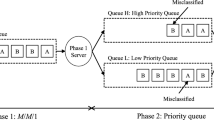Abstract
New services providing automatic call distribution in the network have been one of the most hotly contested areas in the USA telecommunications arena in recent years. This has been fueled by increasing demand from large corporations for intelligent network routing that will keep their geographically distributed telemarketing/service centers operating with maximum efficiency. This paper compares two basic strategies for a network call distributor: a centralized FIFO queue and a distributed queueing strategy called Minimum‐Expected‐Delay (MED). According to MED, a central controller routes each arrival to the node that minimizes its expected delay (waiting time). Our main result qualifies the conventional wisdom that perceives FIFO as optimal. We show that the waiting time under FIFO is not stochastically smaller than that under MED. Furthermore, we prove that the waiting time distribution functions intersect at a single point. Numerical experiments suggest that, for certain performance criteria and over a range of parameters of interest, MED can actually outperform FIFO.
Similar content being viewed by others
Explore related subjects
Discover the latest articles, news and stories from top researchers in related subjects.References
B. Hajek, Optimal control of two interacting service stations, IEEE Trans. Automat. Control 29 (1984) 491–499.
D.J. Houck, Comparison of policies for routing customers to parallel queueing systems, Oper. Res. 35 (1987) 306–310.
P.K. Johri, Optimality of the shortest line discipline with state-dependent service rates, European J. Oper. Res. 41 (1989) 157–161.
Y. Levy, S. Durinovic-Johri and R.A. Milito, Dynamic network call distribution with periodic updates, in: The Fundamental Role of Teletraffic in the Evolution of Telecommunications Networks, Proceedings of 14th ITC, eds. J. Labetoulle and J.W. Roberts (Elsevier, Amsterdam, 1994) pp. 85–94.
R. Menich and R. Serfozo, Optimality of shortest-queue routing for dependent service stations, Queueing Systems 9 (1992) 403–418.
R.A. Milito, Y. Levy and Y. Arian, Dynamic algorithms for distributed queues with abandonments, Teletraffic and Datatraffic in a Period of Change, Proceedings of 13th ITC, eds. A. Jensen and V.B. Iversen (Elsevier, Amsterdam, 1991) pp. 329–334.
D.R. Smith and W. Whitt, Resource sharing for efficiency in traffic systems, Bell Syst. Techn. J. 60 (1981) 39–55.
R.R. Weber, On the optimal assignment of customers to parallel servers, J. Appl. Probab. 15 (1978) 406–413.
Author information
Authors and Affiliations
Rights and permissions
About this article
Cite this article
Kogan, Y., Levy, Y. & Milito, R.A. Call routing to distributed queues: Is FIFO really better than MED?. Telecommunication Systems 7, 299–312 (1997). https://doi.org/10.1023/A:1019132630984
Issue Date:
DOI: https://doi.org/10.1023/A:1019132630984




